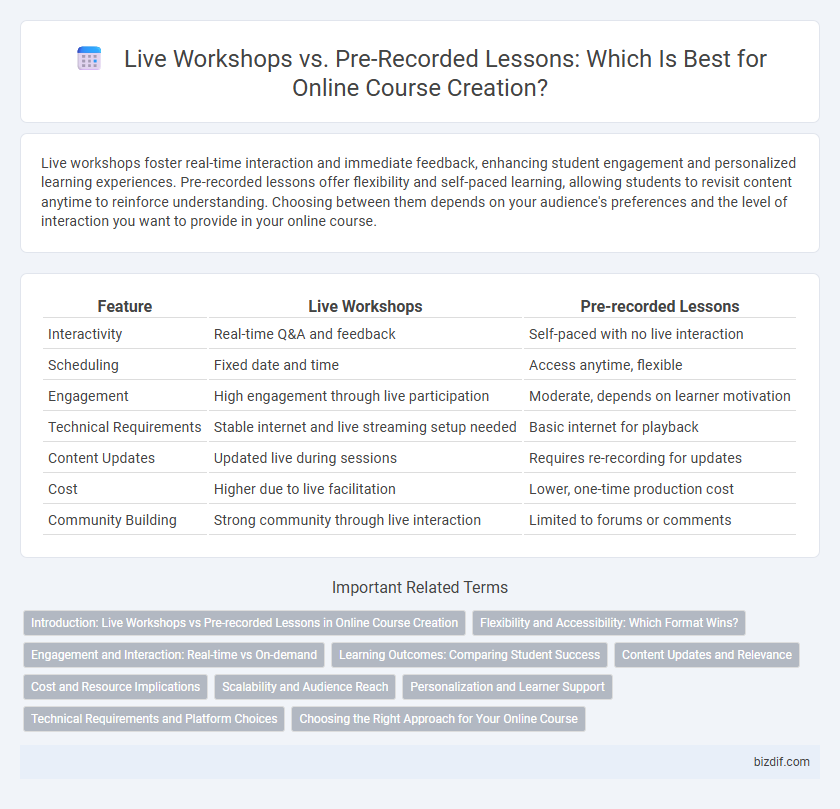Live workshops foster real-time interaction and immediate feedback, enhancing student engagement and personalized learning experiences. Pre-recorded lessons offer flexibility and self-paced learning, allowing students to revisit content anytime to reinforce understanding. Choosing between them depends on your audience's preferences and the level of interaction you want to provide in your online course.
Table of Comparison
| Feature | Live Workshops | Pre-recorded Lessons |
|---|---|---|
| Interactivity | Real-time Q&A and feedback | Self-paced with no live interaction |
| Scheduling | Fixed date and time | Access anytime, flexible |
| Engagement | High engagement through live participation | Moderate, depends on learner motivation |
| Technical Requirements | Stable internet and live streaming setup needed | Basic internet for playback |
| Content Updates | Updated live during sessions | Requires re-recording for updates |
| Cost | Higher due to live facilitation | Lower, one-time production cost |
| Community Building | Strong community through live interaction | Limited to forums or comments |
Introduction: Live Workshops vs Pre-recorded Lessons in Online Course Creation
Live workshops offer real-time interaction, immediate feedback, and a dynamic learning environment, enhancing student engagement in online course creation. Pre-recorded lessons provide flexibility, consistent content delivery, and easy access, catering to diverse learner schedules. Choosing between live workshops and pre-recorded lessons depends on course goals, audience preferences, and the desired level of instructor involvement.
Flexibility and Accessibility: Which Format Wins?
Live workshops offer real-time interaction and immediate feedback, enhancing learner engagement but requiring strict scheduling that limits flexibility. Pre-recorded lessons provide unmatched accessibility by allowing students to learn at their own pace and on their own time, accommodating diverse schedules and time zones. For learners prioritizing convenience and ongoing access, pre-recorded content delivers superior flexibility and accessibility compared to live sessions.
Engagement and Interaction: Real-time vs On-demand
Live workshops foster real-time engagement and dynamic interaction, allowing immediate feedback and personalized responses between instructors and participants. Pre-recorded lessons provide on-demand flexibility but lack the spontaneous dialogue and interactive energy that drive active learning. Prioritizing live sessions enhances collaborative discussions and learner motivation through direct communication and instant clarification.
Learning Outcomes: Comparing Student Success
Live workshops foster real-time interaction, enabling immediate feedback and personalized support, which significantly enhances comprehension and retention rates. Pre-recorded lessons offer flexible pacing but may result in lower engagement, impacting overall student success in complex subjects. Studies indicate that cohorts with live workshop access demonstrate higher completion rates and improved skill application compared to those relying solely on pre-recorded content.
Content Updates and Relevance
Live workshops offer real-time interaction, allowing instructors to update content dynamically based on current trends and participant feedback, ensuring the material remains highly relevant. Pre-recorded lessons provide stable, evergreen content but may risk becoming outdated without regular revisions. Consistent updates in both formats are essential to maintain course relevance and learner engagement.
Cost and Resource Implications
Live workshops require real-time instructor involvement and technology for streaming, leading to higher ongoing costs and resource allocation compared to pre-recorded lessons. Pre-recorded lessons offer scalability with a one-time production expense, allowing unlimited student access without additional instructor time. Investing in pre-recorded content reduces operational costs and frees resources for complementary activities like marketing and student support.
Scalability and Audience Reach
Live workshops foster real-time interaction and personalized feedback but are limited by scheduled timings and participant capacity, constraining scalability. Pre-recorded lessons enable unlimited audience reach, allowing learners to access content anytime, thus facilitating broader scalability and continuous growth. Leveraging pre-recorded content with occasional live sessions can optimize both scalability and engagement for online course creators.
Personalization and Learner Support
Live workshops offer real-time interaction and personalized feedback, fostering a dynamic learning environment that adapts to individual learner needs. Pre-recorded lessons provide flexibility and consistent content delivery but lack immediate support, potentially limiting personalized guidance. Combining live sessions with recorded materials optimizes learner engagement and ensures tailored assistance throughout the course.
Technical Requirements and Platform Choices
Live workshops demand stable high-speed internet, real-time interaction tools, and platforms supporting webinar features like Zoom or Microsoft Teams to ensure seamless communication. Pre-recorded lessons require robust video hosting services such as Vimeo or Teachable, with capabilities for playback control, download options, and compatibility across devices. Selecting platforms like Kajabi or Thinkific can offer hybrid solutions optimizing technical requirements for both live and pre-recorded content delivery.
Choosing the Right Approach for Your Online Course
Live workshops foster real-time interaction, immediate feedback, and personalized support, enhancing learner engagement and motivation. Pre-recorded lessons offer flexibility, scalability, and consistent quality, allowing students to learn at their own pace and revisit content as needed. Selecting the right approach depends on course objectives, audience preferences, and resource availability to maximize educational impact and learner satisfaction.
Live Workshops vs Pre-recorded Lessons Infographic

 bizdif.com
bizdif.com